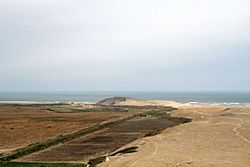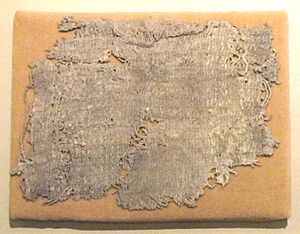Huaca Prieta facts for kids

Panoramic view of Huaca Prieta
|
|
| Lua error in Module:Location_map at line 420: attempt to index field 'wikibase' (a nil value). | |
| Location | La Libertad Province, Peru |
|---|---|
| Region | Chicama Valley |
| Type | settlement |
| History | |
| Founded | ca. 14,500 BP |
| Abandoned | ca. 4000 BP |
| Cultures | El Brujo Archaeological Complex |
| Site notes | |
| Archaeologists | Junius B. Bird |
Huaca Prieta is an ancient settlement located right by the Pacific Ocean. You can find it in the Chicama Valley, just north of Trujillo, in the La Libertad Province of Peru. It is part of the El Brujo Archaeological Complex, which also includes sites from the Moche culture.
People lived at Huaca Prieta as early as 14,500 years ago. This was long before pottery was invented! The site is a huge mound made of ash, stones, old textiles, plants, and shells. It also contains some ancient burials and buildings.
Contents
Discovering Huaca Prieta
Archaeologist Junius B. Bird first explored Huaca Prieta in 1946 and 1947. He dug three large test pits to see what was hidden beneath the surface.
What Archaeologists Found
The items found by Bird are now kept at the American Museum of Natural History in New York City. These include many amazing textiles. These fabrics were made using a special weaving method called "twining." They show detailed pictures of mythical humans, condors, snakes, and crabs.
The stone tools found were quite simple. They included weights for fishing nets, sharp flakes, and basic pebble tools. There were no fancy spear points. In the upper parts of the mound, archaeologists found many underground structures. Their purpose is still a mystery, but some contained burials. These structures were built from cobblestones held together with a mix of ash and water.
The people living here were very resourceful. They caught fish, collected shellfish, and grew many different plants. These included fruits, gourds, squash, peppers, beans, and root vegetables. Most importantly, they grew cotton, which they used to make their textiles.
Nearby Discoveries
About 70 to 170 meters north of Huaca Prieta, there is another low mound called Monticulo Cupisnique. Bird also dug test pits here. He found many ruins and a lot of ancient trash. This included pottery from the Guañape, Early Cupisnique, and Cupisnique cultures. The Cupisnique culture is connected to the highland Chavín culture.
Around 850 BCE, a large tsunami hit the area. It damaged both mounds and left a thick layer of cobblestones. This happened between the two Cupisnique pottery periods.
Ancient Stone Tools
Scientists have studied the oldest layers of Huaca Prieta, dating back 15,000 to 8,000 years ago. These layers show that people were only sometimes present before the main mound was built.
Simple Stone Tools
The stone tools found in these early layers are called "unifacial tools." This means they were only shaped on one side. These simple tools are also found at other ancient sites in South America from the same time. Interestingly, archaeologists did not find any fishhooks or harpoons in these very old layers.
This suggests that the earliest people at Huaca Prieta mainly gathered food along the shoreline. They might have also trapped or clubbed animals that lived nearby.
Archaeologists have looked at over a million stone tools and pieces of stone from this area. They have not found any "bifacial tools," which are shaped on both sides. This means that the early cultures on the north coast of Peru used only unifacial stone tools. The lack of stone, bone, or shell harpoons and fishhooks is also important.
Other Sites with Unifacial Tools
Many other ancient sites in the Americas also have only unifacial stone tools in their oldest layers. For example, the Amotape complex in northern Peru (9,000-7,100 BCE) and the Siches area near the Ecuador border show similar tool use.
The Itaparica tradition in central-northwestern Brazil, from 11,000 to 10,000 years ago, also used only unifacial tools. This period saw a quick increase in people living in Brazil.
In North America, early unifacial tools are often found alongside bifacial tools. Sites like Gault and Friedkin in Texas, Cactus Hill in Virginia, and Paisley Cave in Oregon are examples. All these sites are also older than 14,000 years.
Early Corn Discovery
For a long time, people thought that corn (maize) arrived in this region quite late, after the tsunami.
However, in 2012, scientists made an exciting discovery. They found corncobs at two ancient sites in Peru, Paredones and Huaca Prieta. These corncobs might be as old as 4700 B.C.! This means that people living along the coast of northern Peru were eating corn much earlier than previously thought.
Dolores Piperno and other scientists from Washington's National Museum of Natural History reported these findings. This is the earliest corn ever found in South America.
Archaeologist Tom D. Dillehay noted that several types of early corn were found here. His team discovered the world's oldest collection of corn remains, including stalks and cobs. These included different varieties like ceremonial popcorn, corn used for a beer called chicha, flour corn, and corn for animals.
This suggests that Huaca Prieta was a key place in a large trading network. This network reached all the way to Mexico, where corn first came from.
Oldest Avocado Evidence
Between 2007 and 2013, another team of scientists digging at Huaca Prieta found evidence of the avocado. This evidence might date back 15,000 years! Before this, it was believed that avocados first appeared in Mexico around 8,000 years ago.
Ancient Cotton and Indigo Dye

In 2016, archaeologists found 6,000-year-old dyed cotton fabric at Huaca Prieta. This is the earliest known use of cotton anywhere in the world! It's possible that the type of cotton called Gossypium barbadense was first grown in this region.
Scientists analyzed the color used on the cloth. They found it was indigotin, a type of indigo dye. This means indigo dye was used here much earlier than thought. It was used about 1,500 years before its use in Egypt's Fifth Dynasty.
The people of Huaca Prieta slowly stopped living there. The area became less important as people started to rely more on farming. Other nearby mounds, like Paredones and El Brujo, became more significant.
See also
 In Spanish: Huaca Prieta para niños
In Spanish: Huaca Prieta para niños

